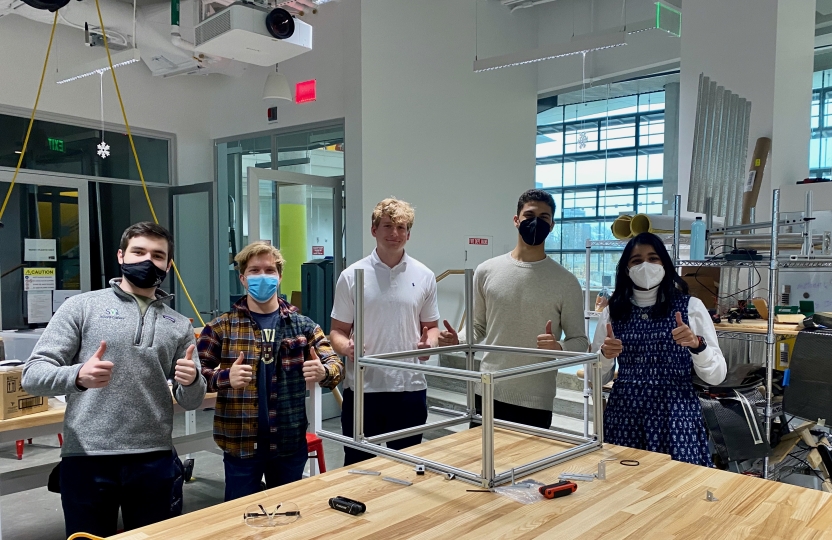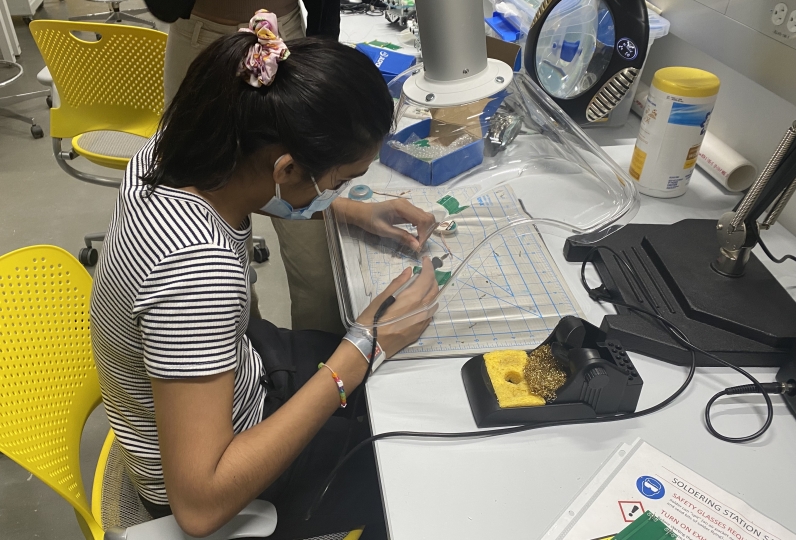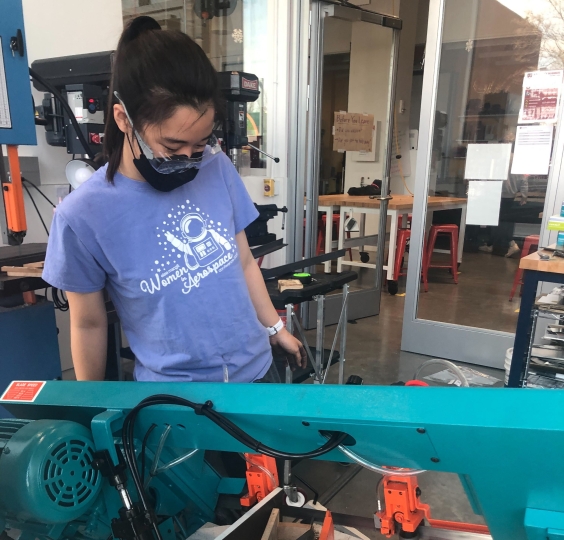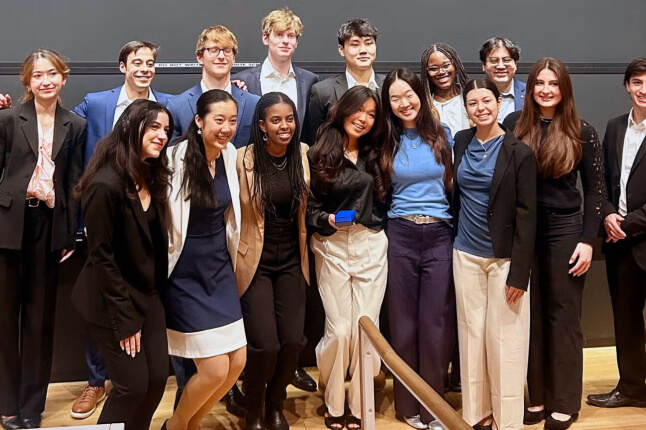News
In the not-too-distant future, a small satellite built by undergraduate students of the Harvard Satellite Team (HST) will reach orbit. The HST will build everything from the satellite’s superstructure to the solar array payload, and even a ground station to send and receive communications once the satellite reaches geostationary orbit. Simultaneously, the Harvard Rocket Propulsion Group (HRPG) is on track to developing the first liquid rocket engines, igniters, and launch vehicles at Harvard. These two independently operating student groups form the Harvard chapter of Students for the Exploration and Development of Space (SEDS), with the expressed purpose of promoting space exploration and interest in space.
The Harvard Rocket Propulsion Group shows off a test stand frame built in the Active Learning Lab at the Science and & Engineering Complex in Allston. From left are group president Ben Schroeder, Ben Fichtenkort, Clayton Donhauser, Nathan Evans and Sirina Prasad. (SEDS)
Students at the Harvard John A. Paulson School of Engineering and Applied Sciences (SEAS) are leading the way at SEDS and its two subgroups. Third-year mechanical engineering student David Andrade is chief engineer for the satellite team, while first-year electrical engineering student Rodrick Shumba is its project manager. Ben Schroeder, a second-year student concentrating in mechanical engineering, heads the rocket group, and several other team leads and officers also have ties to SEAS.
Together, the group wants to make history by building the school’s first undergraduate low-earth orbit satellite. If the satellite, approximately the size of a shoebox and known as a CubeSat because of its shape, is approved through NASA’s CubeSat Launch Initiative, it would launch from Cape Canaveral in Florida or another established launch site. The group could also go through another launch provider, lifting off from a site such as Cape Canaveral, Wallops Flight Facility in Virginia, or Vandenberg Space Force Base in California.
“The mentality of looking at the world, questioning it and seeing in what ways you can explore it more deeply, is incredibly impactful and exciting to me,” Schroeder said. “I don’t see a more profound way to do that than by exploring our universe, going into space, and going into this environment that’s completely alien to what we’ve experienced in the past couple thousand years.”
The Harvard SEDS chapter dates back to the 1990s, but its current project began with the founding of the satellite team in 2018. The team is divided into four subteams: one responsible for the mechanical construction of its superstructure, solar panels, and satellite antennas, known as bus mechanical; one for the computer, power, controls, and communications processing, known as bus electrical; one for the payload of novel nitinol-based solar arrays; and one for the management of the ground station, which communicates with the satellite.
Designing the CubeSat draws on a range of SEAS concentrations and engineering disciplines, making SEDS an organization that welcomes all kinds of students.
Sirina Prasad solders a prototype payload for the Harvard Satellite Team in the Active Learning Lab. (SEDS)
“Bus-mechanical is the creation of solar panels, antenna deployment mechanisms and the superstructure. It’s as mechanical engineering as you can get,” Andrade said. “But then you have bus-electrical and the ground station, which are more software-defined, more electrically defined, and those are spaces for electrical engineers and people who in general like working with electronics and software. And then there’s computer science, which has a large component to the bus-electrical and ground station team.”
Much of the construction and engineering has taken place at the Active Learning Labs at the Science and Engineering Complex, either through organized weekly subteam meetings or individual members working on their own. There’s also an overall group meeting each week.
“The weekly meetings for subteams are normally reserved for work,” Shumba said. “The general meeting is when the subteam leads and other members talk through what’s happened during the week to make sure everyone is onboard.”
Keeping all members on the same page is essential in aerospace engineering. Years of work could literally go up in flames if each group isn’t synchronized with all the others, making participation in SEDS a valuable lesson in collaborative engineering.
“You have to start thinking about how the payload will integrate into the bus, or how the bus will communicate with the ground station,” Schroeder said. “Those kinds of questions about inter-team collaboration really come to the forefront the farther along you get to the project.”
Pandemic restrictions forced SEDS to focus on design and planning last year, but this year the group has been able to begin construction. The Rocket Propulsion Group has spent this semester developing its spark igniter in the Active Learning Lab, and next semester will turn its attention to the liquid engine.
“To see people, especially new members, take ownership of their project components, that’s been really exciting for me to see,” Schroeder said. “We’re really working towards the same thing, and that’s really gratifying.”
Rising fourth-year engineering student Grace Kim machines a part for the Harvard Satellite Team in the Active Learning Lab at the Science & Engineering Complex in Allston. (SEDS)
As far as applying their classwork goes, engineering students might have a hard time finding a more direct application. Andrade can point to using numerous specific lessons and equations from class to address specific challenges with the satellite, and Schroeder similarly described SEDS as a practical proving ground for testing what sometimes seem like theoretical class concepts.
“You see engineering in action in a space where sometimes classes get really theoretical,” Andrade said. “As a freshman or sophomore, I wouldn’t have been able to catch these concepts, and it would’ve been a lot more difficult to grasp these ideas. But as a junior, I’m much more appreciative of the role classes have in building things.”
For Shumba, who just finished his first year at Harvard and has yet to take some of the higher-level courses, it’s the reverse.
“The challenges I see happening in SEDS, I see happening later in class,” Shumba said. “After everything I’ve seen and worked on, the problems I’ve experienced in SEDS, I don’t have to worry about what I might face in a problem set or final class project.”
The challenge for Harvard SEDS is keeping the work going year to year. Joseph Sanchez, who founded the satellite team, has already graduated, and as a junior Andrade knows he might graduate before the intended launch date in 2024.
“You don’t drop a project when you graduate,” Andrade said. “One topic of importance is the role of current team leads in making sure that this is a sustainable club after we’re gone, that we’re not just figureheads that hold up the boat, but that the new members can establish a knowledge base, pick up where we left off and continue sailing.”
For Schroeder, it’s not just about making sure people can continue his work, but also enjoying the steps he’s been part of along the way.
“The meat of the project is the actual development: the ideation from what our payload should be, the design for what it should be, the initial prototyping, the manufacturing,” he said. “It may launch after we’re gone, but anybody can watch the launch and be there when it happens. But to be at a point in the project where you’re getting to make a contribution to what it’s actually going to look like and do, I think that’s really meaningful.”
Working with SEDS hasn’t just been a great application of engineering principles learned in class. Andrade has interned at major aerospace companies SpaceX and Blue Origin, and credited his experiences at SEDS for helping him land those opportunities.
“You see the thing forming before your eyes, and it makes you want to go faster. It makes you want to do more,” Andrade said. “It makes you want to go to the electrical engineering labs on a Saturday at 4 p.m. to fix some boards. That building aspect of it has lit a fire under me to go and make things.”
Topics: Computer Science, Electrical Engineering, Materials Science & Mechanical Engineering, Student Organizations
Cutting-edge science delivered direct to your inbox.
Join the Harvard SEAS mailing list.
Press Contact
Matt Goisman | mgoisman@g.harvard.edu





